
Concept explainers
a.
To identify: The claim and state
a.
Answer to Problem 13E
The claim is that “the variance in the number of calories differs between the two brands”.
Null hypothesis:
Alternative hypothesis:
Explanation of Solution
Given info:
The data shows the areas (in square miles).
Justification:
Here, the claim is that “the variance in area is greater for eastern cities than for western cities”. This can be written as
b.
To find: The critical value for 5% level and 1% level.
b.
Answer to Problem 13E
The critical value at 5% level is 4.950 and the critical value at 1% level is 10.67.
Explanation of Solution
Calculation:
The degrees of freedom for numerator is,
The degrees of freedom for denominator is,
Software Procedure:
Step-by-step procedure to obtain the critical value using the MINITAB software:
- Choose Graph >
Probability Distribution Plot choose View Probability> OK. - From Distribution, choose F.
- Enter Numerator df as 6 and Denominator df as 5.
- Click the Shaded Area tab.
- Choose Probability value and Right Tail for the region of the curve to shade.
- Enter the Probability value as 0.05.
- Click OK.
Output using the MINITAB software is given below:
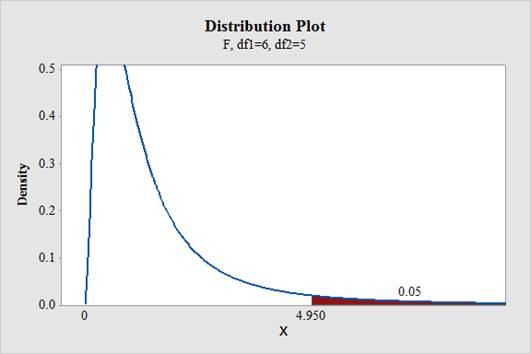
From the output, the critical value is 4.950.
Level of significance,
Software Procedure:
Step-by-step procedure to obtain the critical value using the MINITAB software:
- Choose Graph > Probability Distribution Plot choose View Probability> OK.
- From Distribution, choose F.
- Enter Numerator df as 6 and Denominator df as 5.
- Click the Shaded Area tab.
- Choose Probability value and Right Tail for the region of the curve to shade.
- Enter the Probability value as 0.01.
- Click OK.
Output using the MINITAB software is given below:
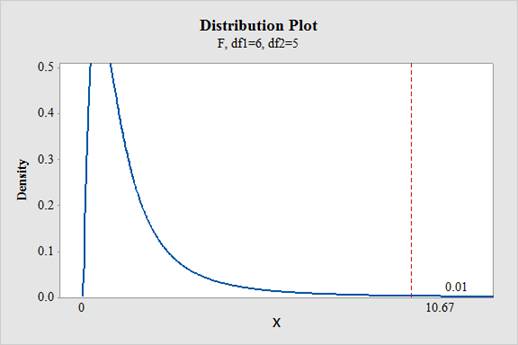
From the output, the critical value is 10.67.
c.
To find: The test value.
c.
Answer to Problem 13E
The test statistic value is 9.80.
Explanation of Solution
Calculation:
Software Procedure:
Step-by-step procedure to obtain the test value using the MINITAB software:
- Choose Stat > Basic Statistics >2 Variance.
- Choose Each sample is in its own column.
- In Sample 1, enter the column of Eastern.
- In Sample 2, enter the column of Western.
- Check Options; enter Confidence level as 95%.
- Choose greater than in alternative.
- Click OK.
Output using the MINITAB software is given below:
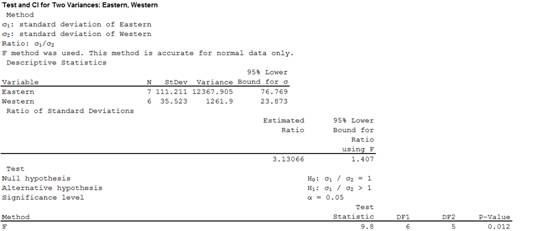
From the output, the test value is 9.80.
d.
To decide: Whether to reject or fail to reject the null hypothesis at a level of significance of
d.
Answer to Problem 13E
For 5% level, the decision is “reject the null hypothesis”.
For 1% level, the decision is “fail to reject the null hypothesis”.
Explanation of Solution
Calculation:
Software Procedure:
Step-by-step procedure to indicate the appropriate area and critical value using the MINITAB software:
- Choose Graph > Probability Distribution Plot choose View Probability> OK.
- From Distribution, choose F.
- Enter Numerator df as 8 and Denominator df as 8.
- Click the Shaded Area tab.
- Choose Probability value and Both Tail for the region of the curve to shade.
- Enter the Probability value as 0.05.
- Enter 9.80 under show reference lines at X values
- Click OK.
Output using the MINITAB software is given below:
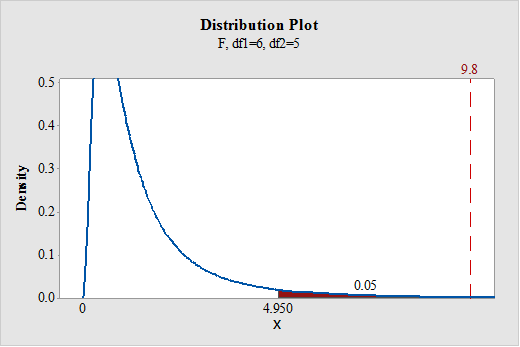
From the output, it can be observed that the test statistic value falls in the rejection region. Therefore, the null hypothesis is rejected.
Software Procedure:
Step-by-step procedure to indicate the appropriate area and critical value using the MINITAB software:
- Choose Graph > Probability Distribution Plot choose View Probability> OK.
- From Distribution, choose F.
- Enter Numerator df as 8 and Denominator df as 8.
- Click the Shaded Area tab.
- Choose Probability value and Both Tail for the region of the curve to shade.
- Enter the Probability value as 0.01.
- Enter 9.80 under show reference lines at X values
- Click OK.
Output using the MINITAB software is given below:
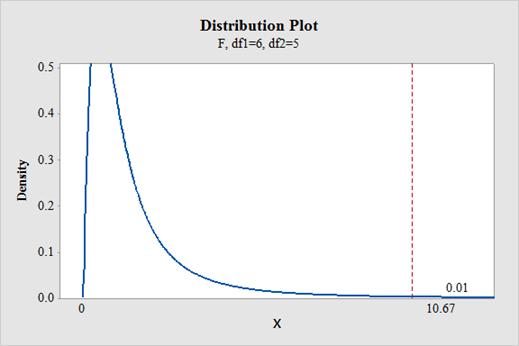
From the output, it can be observed that the test statistic value do not falls in the rejection region. Therefore, the null hypothesis is not rejected.
e.
To summarize: The result.
e.
Answer to Problem 13E
The conclusion is that, there is enough evidence to support the claim that the variance in area is greater for eastern cities than for western cities at 5% level of significance.
The conclusion is that, there is no enough evidence to support the claim that the variance in area is greater for eastern cities than for western cities at 1% level of significance.
Explanation of Solution
Justification:
For 5% level:
From part (d), the null hypothesis is rejected. Thus, there is enough evidence to support the claim that the variance in area is greater for eastern cities than for western citiesat 5% level of significance.
For 1% level:
From part (d), the null hypothesis is not rejected. Thus, there is no enough evidence to support the claim that the variance in area is greater for eastern cities than for western cities at 1% level of significance.
Want to see more full solutions like this?
Chapter 9 Solutions
ELEMENTARY STATISTICS CONNECT CODE>CUS
- Examine the Variables: Carefully review and note the names of all variables in the dataset. Examples of these variables include: Mileage (mpg) Number of Cylinders (cyl) Displacement (disp) Horsepower (hp) Research: Google to understand these variables. Statistical Analysis: Select mpg variable, and perform the following statistical tests. Once you are done with these tests using mpg variable, repeat the same with hp Mean Median First Quartile (Q1) Second Quartile (Q2) Third Quartile (Q3) Fourth Quartile (Q4) 10th Percentile 70th Percentile Skewness Kurtosis Document Your Results: In RStudio: Before running each statistical test, provide a heading in the format shown at the bottom. “# Mean of mileage – Your name’s command” In Microsoft Word: Once you've completed all tests, take a screenshot of your results in RStudio and paste it into a Microsoft Word document. Make sure that snapshots are very clear. You will need multiple snapshots. Also transfer these results to the…arrow_forward2 (VaR and ES) Suppose X1 are independent. Prove that ~ Unif[-0.5, 0.5] and X2 VaRa (X1X2) < VaRa(X1) + VaRa (X2). ~ Unif[-0.5, 0.5]arrow_forward8 (Correlation and Diversification) Assume we have two stocks, A and B, show that a particular combination of the two stocks produce a risk-free portfolio when the correlation between the return of A and B is -1.arrow_forward
- 9 (Portfolio allocation) Suppose R₁ and R2 are returns of 2 assets and with expected return and variance respectively r₁ and 72 and variance-covariance σ2, 0%½ and σ12. Find −∞ ≤ w ≤ ∞ such that the portfolio wR₁ + (1 - w) R₂ has the smallest risk.arrow_forward7 (Multivariate random variable) Suppose X, €1, €2, €3 are IID N(0, 1) and Y2 Y₁ = 0.2 0.8X + €1, Y₂ = 0.3 +0.7X+ €2, Y3 = 0.2 + 0.9X + €3. = (In models like this, X is called the common factors of Y₁, Y₂, Y3.) Y = (Y1, Y2, Y3). (a) Find E(Y) and cov(Y). (b) What can you observe from cov(Y). Writearrow_forward1 (VaR and ES) Suppose X ~ f(x) with 1+x, if 0> x > −1 f(x) = 1−x if 1 x > 0 Find VaRo.05 (X) and ES0.05 (X).arrow_forward
- Joy is making Christmas gifts. She has 6 1/12 feet of yarn and will need 4 1/4 to complete our project. How much yarn will she have left over compute this solution in two different ways arrow_forwardSolve for X. Explain each step. 2^2x • 2^-4=8arrow_forwardOne hundred people were surveyed, and one question pertained to their educational background. The results of this question and their genders are given in the following table. Female (F) Male (F′) Total College degree (D) 30 20 50 No college degree (D′) 30 20 50 Total 60 40 100 If a person is selected at random from those surveyed, find the probability of each of the following events.1. The person is female or has a college degree. Answer: equation editor Equation Editor 2. The person is male or does not have a college degree. Answer: equation editor Equation Editor 3. The person is female or does not have a college degree.arrow_forward
 Glencoe Algebra 1, Student Edition, 9780079039897...AlgebraISBN:9780079039897Author:CarterPublisher:McGraw Hill
Glencoe Algebra 1, Student Edition, 9780079039897...AlgebraISBN:9780079039897Author:CarterPublisher:McGraw Hill College Algebra (MindTap Course List)AlgebraISBN:9781305652231Author:R. David Gustafson, Jeff HughesPublisher:Cengage Learning
College Algebra (MindTap Course List)AlgebraISBN:9781305652231Author:R. David Gustafson, Jeff HughesPublisher:Cengage Learning Holt Mcdougal Larson Pre-algebra: Student Edition...AlgebraISBN:9780547587776Author:HOLT MCDOUGALPublisher:HOLT MCDOUGAL
Holt Mcdougal Larson Pre-algebra: Student Edition...AlgebraISBN:9780547587776Author:HOLT MCDOUGALPublisher:HOLT MCDOUGAL





